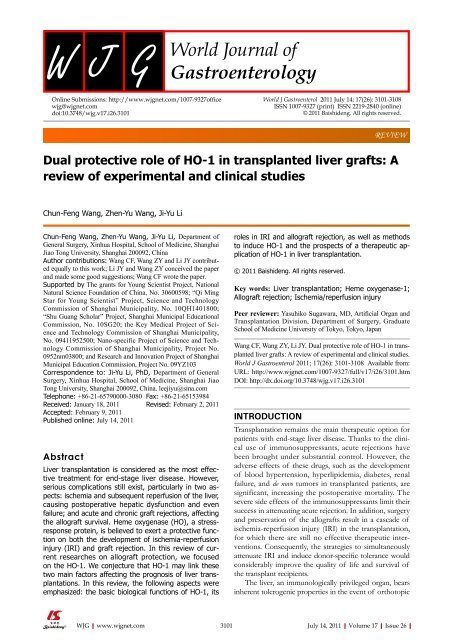26 - World Journal of Gastroenterology
26 - World Journal of Gastroenterology
26 - World Journal of Gastroenterology
You also want an ePaper? Increase the reach of your titles
YUMPU automatically turns print PDFs into web optimized ePapers that Google loves.
Online Submissions: http://www.wjgnet.com/1007-9327<strong>of</strong>fice<br />
wjg@wjgnet.com<br />
doi:10.3748/wjg.v17.i<strong>26</strong>.3101<br />
Dual protective role <strong>of</strong> HO-1 in transplanted liver grafts: A<br />
review <strong>of</strong> experimental and clinical studies<br />
Chun-Feng Wang, Zhen-Yu Wang, Ji-Yu Li<br />
Chun-Feng Wang, Zhen-Yu Wang, Ji-Yu Li, Department <strong>of</strong><br />
General Surgery, Xinhua Hospital, School <strong>of</strong> Medicine, Shanghai<br />
Jiao Tong University, Shanghai 200092, China<br />
Author contributions: Wang CF, Wang ZY and Li JY contributed<br />
equally to this work; Li JY and Wang ZY conceived the paper<br />
and made some good suggestions; Wang CF wrote the paper.<br />
Supported by The grants for Young Scientist Project, National<br />
Natural Science Foundation <strong>of</strong> China, No. 30600598; “Qi Ming<br />
Star for Young Scientist” Project, Science and Technology<br />
Commission <strong>of</strong> Shanghai Municipality, No. 10QH1401800;<br />
“Shu Guang Scholar” Project, Shanghai Municipal Educational<br />
Commission, No. 10SG20; the Key Medical Project <strong>of</strong> Science<br />
and Technology Commission <strong>of</strong> Shanghai Municipality,<br />
No. 09411952500; Nano-specific Project <strong>of</strong> Science and Technology<br />
Commission <strong>of</strong> Shanghai Municipality, Project No.<br />
0952nm03800; and Research and Innovation Project <strong>of</strong> Shanghai<br />
Municipal Education Commission, Project No. 09YZ103<br />
Correspondence to: Ji-Yu Li, PhD, Department <strong>of</strong> General<br />
Surgery, Xinhua Hospital, School <strong>of</strong> Medicine, Shanghai Jiao<br />
Tong University, Shanghai 200092, China. leejiyu@sina.com<br />
Telephone: +86-21-65790000-3080 Fax: +86-21-65153984<br />
Received: January 18, 2011 Revised: February 2, 2011<br />
Accepted: February 9, 2011<br />
Published online: July 14, 2011<br />
Abstract<br />
Liver transplantation is considered as the most effective<br />
treatment for end-stage liver disease. However,<br />
serious complications still exist, particularly in two aspects:<br />
ischemia and subsequent reperfusion <strong>of</strong> the liver,<br />
causing postoperative hepatic dysfunction and even<br />
failure; and acute and chronic graft rejections, affecting<br />
the allograft survival. Heme oxygenase (HO), a stressresponse<br />
protein, is believed to exert a protective function<br />
on both the development <strong>of</strong> ischemia-reperfusion<br />
injury (IRI) and graft rejection. In this review <strong>of</strong> current<br />
researches on allograft protection, we focused<br />
on the HO-1. We conjecture that HO-1 may link these<br />
two main factors affecting the prognosis <strong>of</strong> liver transplantations.<br />
In this review, the following aspects were<br />
emphasized: the basic biological functions <strong>of</strong> HO-1, its<br />
WJG|www.wjgnet.com<br />
<strong>World</strong> J Gastroenterol 2011 July 14; 17(<strong>26</strong>): 3101-3108<br />
ISSN 1007-9327 (print) ISSN 2219-2840 (online)<br />
© 2011 Baishideng. All rights reserved.<br />
roles in IRI and allograft rejection, as well as methods<br />
to induce HO-1 and the prospects <strong>of</strong> a therapeutic application<br />
<strong>of</strong> HO-1 in liver transplantation.<br />
© 2011 Baishideng. All rights reserved.<br />
Key words: Liver transplantation; Heme oxygenase-1;<br />
Allograft rejection; Ischemia/reperfusion injury<br />
Peer reviewer: Yasuhiko Sugawara, MD, Artificial Organ and<br />
Transplantation Division, Department <strong>of</strong> Surgery, Graduate<br />
School <strong>of</strong> Medicine University <strong>of</strong> Tokyo, Tokyo, Japan<br />
Wang CF, Wang ZY, Li JY. Dual protective role <strong>of</strong> HO-1 in transplanted<br />
liver grafts: A review <strong>of</strong> experimental and clinical studies.<br />
<strong>World</strong> J Gastroenterol 2011; 17(<strong>26</strong>): 3101-3108 Available from:<br />
URL: http://www.wjgnet.com/1007-9327/full/v17/i<strong>26</strong>/3101.htm<br />
DOI: http://dx.doi.org/10.3748/wjg.v17.i<strong>26</strong>.3101<br />
INTRODUCTION<br />
REVIEW<br />
Transplantation remains the main therapeutic option for<br />
patients with end-stage liver disease. Thanks to the clinical<br />
use <strong>of</strong> immunosuppressants, acute rejections have<br />
been brought under substantial control. However, the<br />
adverse effects <strong>of</strong> these drugs, such as the development<br />
<strong>of</strong> blood hypertension, hyperlipidemia, diabetes, renal<br />
failure, and de novo tumors in transplanted patients, are<br />
significant, increasing the postoperative mortality. The<br />
severe side effects <strong>of</strong> the immunosuppressants limit their<br />
success in attenuating acute rejection. In addition, surgery<br />
and preservation <strong>of</strong> the allografts result in a cascade <strong>of</strong><br />
ischemia-reperfusion injury (IRI) in the transplantation,<br />
for which there are still no effective therapeutic interventions.<br />
Consequently, the strategies to simultaneously<br />
attenuate IRI and induce donor-specific tolerance would<br />
considerably improve the quality <strong>of</strong> life and survival <strong>of</strong><br />
the transplant recipients.<br />
The liver, an immunologically privileged organ, bears<br />
inherent tolerogenic properties in the event <strong>of</strong> orthotopic<br />
3101 July 14, 2011|Volume 17|Issue <strong>26</strong>|

















